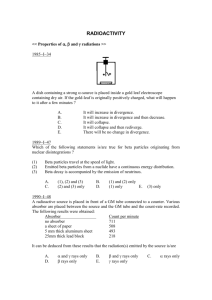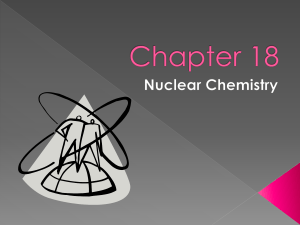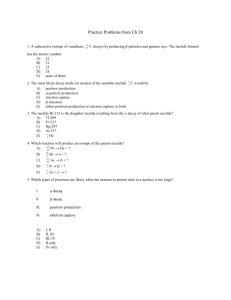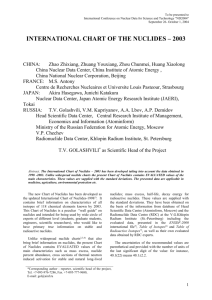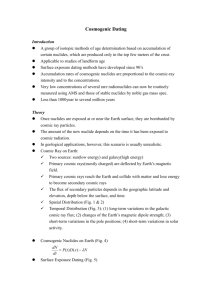Exploring Nuclides, Nuclear Stability, Binding Energies, Nuclear
advertisement
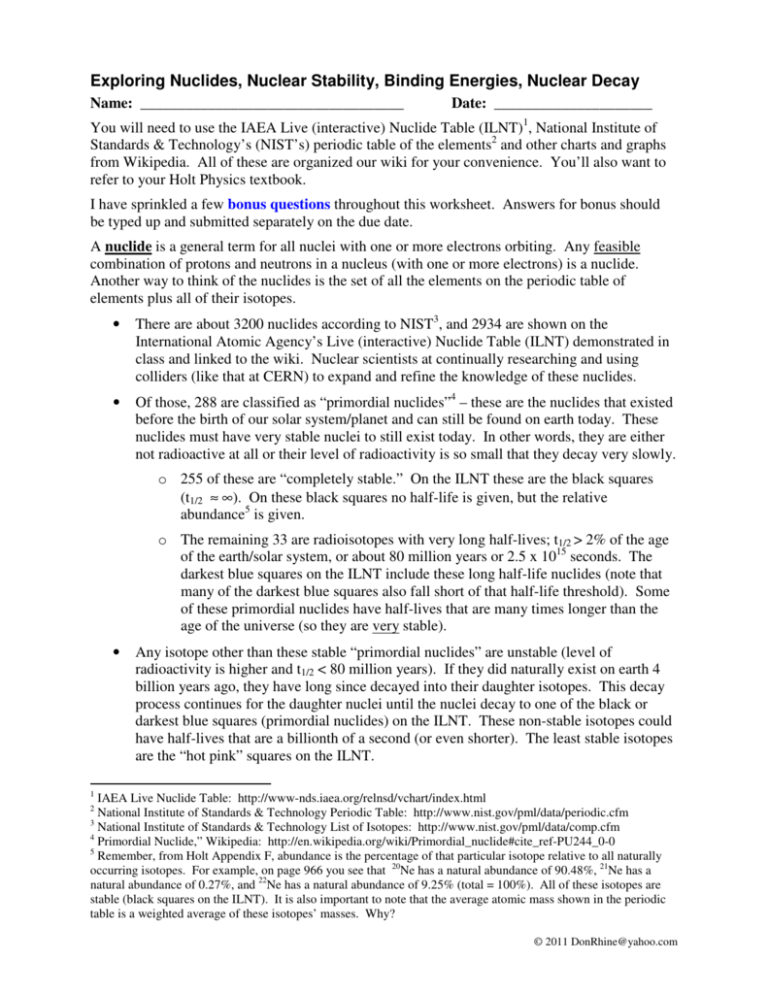
Exploring Nuclides, Nuclear Stability, Binding Energies, Nuclear Decay Name: ___________________________________ Date: _____________________ You will need to use the IAEA Live (interactive) Nuclide Table (ILNT)1, National Institute of Standards & Technology’s (NIST’s) periodic table of the elements2 and other charts and graphs from Wikipedia. All of these are organized our wiki for your convenience. You’ll also want to refer to your Holt Physics textbook. I have sprinkled a few bonus questions throughout this worksheet. Answers for bonus should be typed up and submitted separately on the due date. A nuclide is a general term for all nuclei with one or more electrons orbiting. Any feasible combination of protons and neutrons in a nucleus (with one or more electrons) is a nuclide. Another way to think of the nuclides is the set of all the elements on the periodic table of elements plus all of their isotopes. • There are about 3200 nuclides according to NIST3, and 2934 are shown on the International Atomic Agency’s Live (interactive) Nuclide Table (ILNT) demonstrated in class and linked to the wiki. Nuclear scientists at continually researching and using colliders (like that at CERN) to expand and refine the knowledge of these nuclides. • Of those, 288 are classified as “primordial nuclides”4 – these are the nuclides that existed before the birth of our solar system/planet and can still be found on earth today. These nuclides must have very stable nuclei to still exist today. In other words, they are either not radioactive at all or their level of radioactivity is so small that they decay very slowly. o 255 of these are “completely stable.” On the ILNT these are the black squares (t1/2 ≈ ∞). On these black squares no half-life is given, but the relative abundance5 is given. o The remaining 33 are radioisotopes with very long half-lives; t1/2 > 2% of the age of the earth/solar system, or about 80 million years or 2.5 x 1015 seconds. The darkest blue squares on the ILNT include these long half-life nuclides (note that many of the darkest blue squares also fall short of that half-life threshold). Some of these primordial nuclides have half-lives that are many times longer than the age of the universe (so they are very stable). • Any isotope other than these stable “primordial nuclides” are unstable (level of radioactivity is higher and t1/2 < 80 million years). If they did naturally exist on earth 4 billion years ago, they have long since decayed into their daughter isotopes. This decay process continues for the daughter nuclei until the nuclei decay to one of the black or darkest blue squares (primordial nuclides) on the ILNT. These non-stable isotopes could have half-lives that are a billionth of a second (or even shorter). The least stable isotopes are the “hot pink” squares on the ILNT. 1 IAEA Live Nuclide Table: http://www-nds.iaea.org/relnsd/vchart/index.html National Institute of Standards & Technology Periodic Table: http://www.nist.gov/pml/data/periodic.cfm 3 National Institute of Standards & Technology List of Isotopes: http://www.nist.gov/pml/data/comp.cfm 4 Primordial Nuclide,” Wikipedia: http://en.wikipedia.org/wiki/Primordial_nuclide#cite_ref-PU244_0-0 5 Remember, from Holt Appendix F, abundance is the percentage of that particular isotope relative to all naturally occurring isotopes. For example, on page 966 you see that 20Ne has a natural abundance of 90.48%, 21Ne has a natural abundance of 0.27%, and 22Ne has a natural abundance of 9.25% (total = 100%). All of these isotopes are stable (black squares on the ILNT). It is also important to note that the average atomic mass shown in the periodic table is a weighted average of these isotopes’ masses. Why? 2 © 2011 DonRhine@yahoo.com Exploring Nuclear Stability and Primordial Nuclides Questions: 1. Look up the word “primordial” and write your definition below. The first definition at dictionary.com is a nice one. 2. Re-read footnote 5 on the previous page. Use the space below to show that the weighted average of the isotope masses (in Holt Appendix F page 964) equals the average atomic mass shown on the periodic table (Holt Appendix E). 3. Why would it be appropriate to show the weighted average for an element’s atomic mass rather than the most prevalent (abundant) isotope’s mass? 4. Go to the IAEA’s Live Nuclide Table (ILNT) and take a look (I posted a link to a version that requires Java on your computer, but there is also a link to a not-as-nice html version). I also posted a few PowerPoint slides (pdf format) on the wiki if you need help reading the ILNT info panel data. Compare the ILNT chart to the Holt Figure 25-3 on page 899. What is used for the axes for these charts? “x-axis” (abscissa) “y-axis” (ordinate) Holt Fig 25-3 ILNT 5. According to Holt Appendix F, if you have a 1 kg of “pure” Cadmium (Cd), how many isotopes of Cd would you likely find in that sample? List them in the table below. If it’s a radioisotope (radioactive), find the half-life, decay mode, and daughter nuclides using the ILNT. For example, if you looked up 232Pa, it has a half-life of 1.31 days (you will see “1.31 2 d” displayed; you may ignore the digit “2”)6. Data from Holt Appendix F Page 969 Isotope Radioactive? Halflife Abundance Data from IAEA Live Nuclide Table Half-life Abundance Decay Mode(s) Daughter Nuclide(s) 6. Does the data in Holt match the data from the IAEA? IAEA uses the more recent data (2006). It’s nice to check these figures for accuracy occasionally! 6 You may ignore these extra numbers. But I will give you +2 Bonus points if you can figure out what that “2” represents. Another example: 224Ac has a half-life of 2.78 days (“2.78 17 d” is shown on the ILNT). What does the “17” mean? © 2011 DonRhine@yahoo.com Exploring Nuclear Stability and Primordial Nuclides (continued) 7. If you revisit that 1 kg sample an hour later (or even 1 second later), would it still be pure (100%) Cd? If not, what else would you find? 8. From your reading on the first page, which of these Cd nuclides (isotopes in this case because they all have the same atomic number, Z), would you classify as “primordial nuclides” (t1/2 > ~80 million years)? 9. Look at Appendix F. Are there any radioactive isotopes with a non-zero natural abundance that are NOT classified as “primordial nuclides”? List those that you find. 10. How many elements are on the periodic table? If you are using your textbook Appendix E, you’ll need to add five (there are five transuranic7 elements not included in your text). 11. Take a look at the color codes on the NIST periodic table (link on wiki). a. What does yellow indicate? b. How many elements are NOT found in nature (zero abundance)? c. There are two element colored in yellow that seems to be out of place relative to the others (look at the atomic numbers). What are they? Look them up on the ILNT and compare the color of the squares for those elements to those above and below it. What color is missing and why does this make sense? Look up those two elements in Holt Appendix F. Why are they “missing”? d. For the rest of these yellow-colored squares on NIST’s periodic table, what is the lowest atomic number in this group? Also give the element name and average atomic mass. e. If you look on the ILNT for these elements in 11(d), where are they located (up, down, left, or right) and what do you notice about the colors of the squares? Which color(s) is (are) missing? Why does this make sense? 12. If you look back at Holt Figure 25-3, what are the two largest stable nuclides? You might want to reread the discussion on page the bottom of page 898 to the top of page 900. Give the elements’ symbol with A and Z numbers. Is this consistent with your answers for #11? Why? 7 Supplemental reading: “Transuranium Elements,” Wikipedia: http://en.wikipedia.org/wiki/Transuranium_element © 2011 DonRhine@yahoo.com Finding the 33 Primoridial Radioisotopes If figure 25-3 plots the stable primordial nuclides, how do you find the 33 radioactive primordial nuclides? Let’s use two different methods… Method 1: Look for radioactive isotopes with half-lives greater than 80 million years in Holt Appendix F. Remember, these primordial nuclides are radioisotopes that are stable enough to still be present on earth today, so look for those that have some natural abundance. Method 2: Use the “filter panel” on the IAEA Live Nuclide Table to filter out all of the shorter halflife nuclides. To do this, click on the yellow “filter panel” square. When the filter panel pops up, use your curser to move the yellow rectangle on the left side of the “half-life” slide all the way to the right (toward “stable”). As you do so, you’ll see nearly all of the nuclide blocks on the table turn white as they are filtered out, leaving only black and darkest blue blocks. You can now click on the darkest blue blocks to see if the half-lives are greater than 80 million years. If the ILNT provides abundance rather than half-life, the half-life is much greater than 80 million years (some have half-lives of 1024 years!). 13. Use method 1 to identify the two primordial radioisotopes on page 968 of Appendix F. Symbol w/ atomic number & mass Abundance ½ life 14. Use method 2 to identify the four primordial radioisotopes with atomic numbers greater than that of the largest stable nuclide (see #12). Use Holt Appendix F to check your answers, but you’ll find that Holt is not in agreement with the definition! Symbol w/ atomic number & mass Abundance ½ life 15. One might think that there should be no other nuclides present on earth except for those 288 primordial nuclides. All other radioisotopes should have decayed to nothingness long ago. However, you still find trace amounts of many different elements in nature! For each example below, use Google to determine how each still exists today (each reason is different!). Google “source of xx”. a. 14 b. 241 c. A C has t1/2 = 5730 years found in all living things Am has t1/2 = 432 years used in smoke detectors Rn– all isotopes of radon are less than 3 days, but if you are not careful, you can find dangerous levels of radon gas in your basement (leaching in from the ground). In Holt Fig. 25-3, the black dots represent all of the stable nuclides (there should be 255 according to the introductory reading). Scientists coined the term “valley of stability” for this region. © 2011 DonRhine@yahoo.com Exploring the Nuclear “Valley of Stability” The diagram to the right8 gives a better idea of this concept in the form of 3D relief model of a valley coming down from some distant mountains. Pretend you are standing a printed version of the ILNT, at the origin, with your eyes looking along the line formed by the stable elements (the black squares are receding into the distance, up the floor of the valley). The floor of the valley represents the black squares on the ILNT and the black dots in Holt Fig. 25-3. Unstable nuclei will decay and “roll” into the valley as they decay. If you look at the ILNT chart, the walls of the valley are the colored squares. The further a nuclide is from the valley, the higher it is on the ridge above the valley, and the more unstable it is (closer and closer to the pink squares in the ILNT). The "valley of stability" - new nuclear machines such as the Rare Isotope Accelerator will open up studies of nuclear phenomena using beams of short-lived isotopes, which form the high "walls" of the valley.8 Super-heavy, highly unstable elements are in the distant mountains and they “wash down into the valley” as they decay into smaller and smaller more stable nuclides from #12. 16. Fill out the summary table of major nuclear decay modes below (5 types, not including neutrinos, but show neutrinos as well). Then describe the effect of each on the nucleus (how does it move on the nuclide chart). Use arrows and symbols to show the movement on the mini nuclide chart to the left starting at ♣. Note the axis labels match the ILNT (opposite of Holt fig 25-3). Z Decay Mode Name Symbol Symbol w/ mass & charge Effect on nucleus ♣ N 17. Radioisotopes with an excessive amount of protons… a. … are located on which side of the valley? Left or right? b. Which type of decay “converts” a proton to a neutron? c. Go into to the filter panel and turn off all the decay modes other than the ones you chose in part (b). Is your answer correct? Looking at the ILNT and your mini-nuclide chart above, can see why it appears that those nuclides are “rolling down” into the “valley of stability” below? Explain! (1-2 sentences) 8 “Climbing Out of the Nuclear Valley,” CERN Courier, The International Journal of High Energy Physics, February 22, 2002. http://cerncourier.com/cws/article/cern/28587 © 2011 DonRhine@yahoo.com Exploring the Nuclear “Valley of Stability” 18. Radioisotopes with an excessive amount of neutron… a. … are located on which side of the valley? Left or right? b. Which type of decay “converts” a neutron to a proton? c. Go into to the filter panel and turn off all the decay modes other than the ones you chose in part (b). Is your answer correct? Looking at the ILNT and your mini-nuclide chart above, can see why it appears that those nuclides are “rolling down” into the “valley of stability” below? Explain! (1-2 sentences) 19. Using this “valley of stability” analogy, how would you describe the motion of an isotope that undergoes an alpha decay? Plotting Decay Series The four superheavy primordial radioisotiopes you found in question #14 are all in the “mountains” in the “Valley of Stability”. Over time as they undergo natural nuclear decay, they move down into a heavy isotope that is stable. An example of one of these decay series is shown in Holt Fig. 25-6(b). 20. Using the blank nuclide chart below, map out the first three steps in the decay chain. Do the following for each step… Z • Use ILNT to look up the decay mode(s) 222 86 4 2 222 86 Rn 218 84 Rn → He + Po • Write out the decay formula • Write down the half-life • Show the transition on the nuclide table • An example is shown to the right • Sometimes the nucleus may have more than one decay mode—this will result in a branch on the decay chain as shown in the example. 218 85 t½ = 3.82d Pb α β− (0.02%) α 218 84 Po α (99.98%) 214 82 Po Equations Half-lives_____________ N N a. b. c. Bonus (10 points): Map out the entire decay path for 241Am (provide all the information shown above) © 2011 DonRhine@yahoo.com Calculating and Interpreting Binding Energies asdf © 2011 DonRhine@yahoo.com


